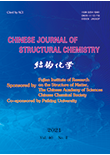Influence of Ligand with Fine Difference at Donor Site on MMCT Property in Binuclear Mixed Valence Complexes
LI Su-Hua, YANG Yu-Ying, ZHANG Yu-Xiao, WU Xin-Tao and SHENG Tian-Lu*
Chin. J. Struct. Chem. 2021, 40, 207-216 DOI: 10.14102/j.cnki.0254-5861.2011-2811
February 15, 2021
metal-to-metal charge transfer (MMCT), mixed-valence complexes, Class II
ABSTRACT
To investigate how the electronic effect of ligand at donor site
influences electronic communication or metal-to-metal charge transfer (MMCT)
properties in similar mixed-valence (MV) complexes, a series of binuclear
organometallic complexes, MeCp(dppe)RuCNFeCl3 (1), MeCp(PPh3)2RuCNFeCl3 (2), Cp*(dppe)FeCNFeCl3 (3), Cp*(dppe)RuCNFeCl3 (4) and Cp*(PPh3)2RuCNFeCl3 (5), have been synthesized and
characterized. The electronic absorptions of these complexes show the presence
of MMCT properties between RuII or FeII and FeIII ions, strongly supported by the theoretical calculations. With increasing electron-donating
ability of ligands (PPh3 > dppe, Cp* > MeCp) at donor site, the
MMCT absorption bands are red-shifted, which expresses in the sequence of absorption
bands with 1 (500 nm), 4 (536 nm), 2 (542 nm), 5 (580 nm)
from high-energy to low-energy. Meanwhile, the MMCT absorption energy of 4 (536 nm) is larger than that of 3 (760 nm) due to the stronger
electron-donating ability of FeII than RuII. Furthermore,
these complexes belong to the Class II systems according to the Robin and Day’s
classification.








